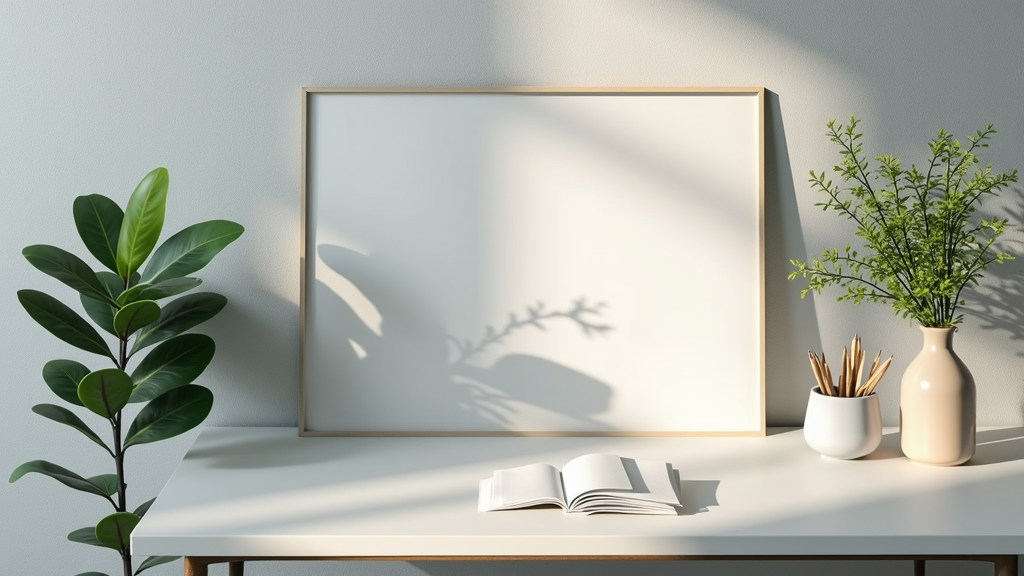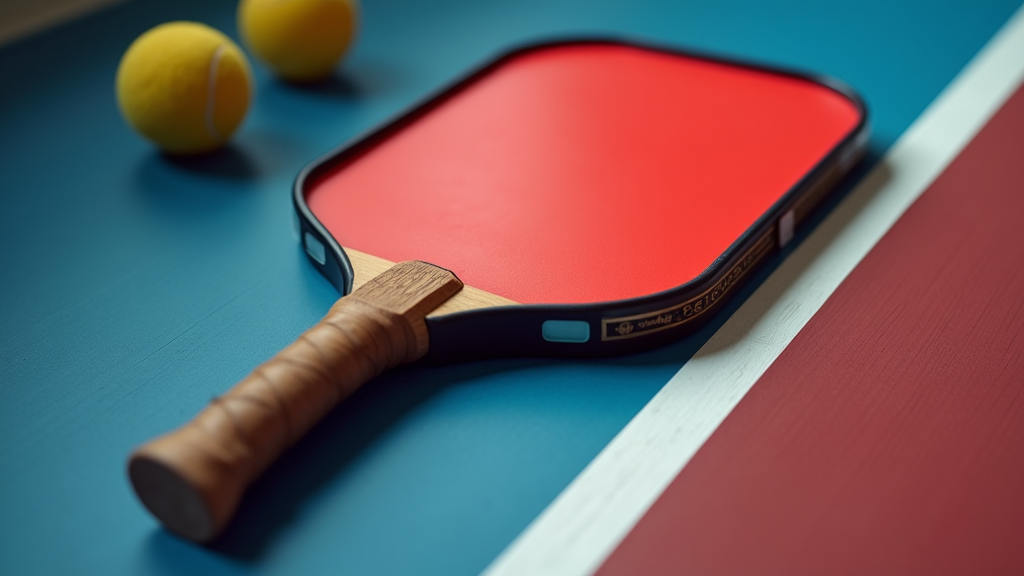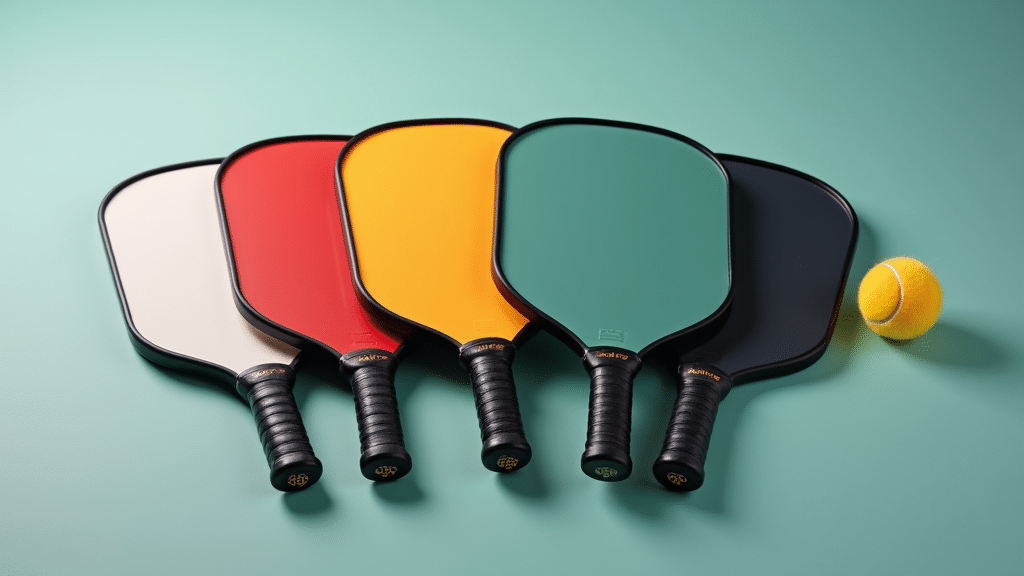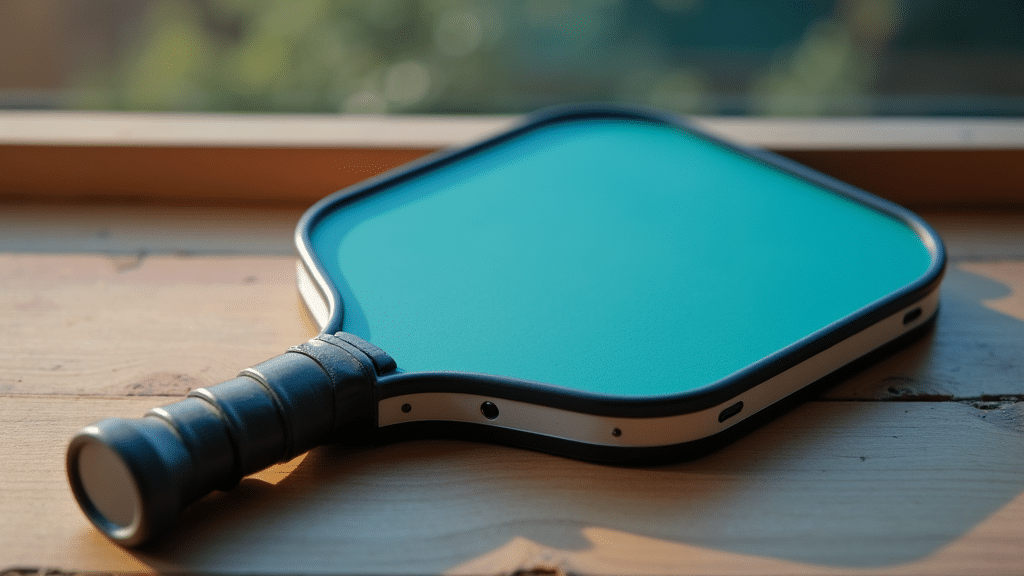Table of Contents
Introduction

Overview and Importance
The edge guard on a pickleball paddle is a crucial component, frequently subjected to wear and tear, leading to it becoming loose or even falling off entirely. This protective strip around the paddle’s perimeter is more than just a cosmetic feature; it plays a vital role in maintaining the paddle’s structural integrity.
The importance of the edge guard cannot be overstated. It acts as a shield, protecting the paddle’s core and surface layers from impacts, abrasions, and general wear. Without a functional edge guard, the paddle is vulnerable to damage that can compromise its performance and lifespan. Paddle damage leads to performance decline in 60% of recreational players, showing the importance of protecting your investment.
A damaged edge guard can lead to paddle delamination, where the layers of the paddle begin to separate. This separation results in a loss of power, control, and overall playability, significantly impacting your game.
Background
In the early days of pickleball, paddles often lacked edge guards, or featured rudimentary ones that offered minimal protection. This design flaw resulted in rapid degradation of the paddle’s edges, significantly shortening their lifespan. Players quickly realized the need for a more robust solution to protect their equipment.
Recent developments in paddle technology have led to the use of more durable materials and improved designs for edge guards. Modern paddles often incorporate edge guards made from high-impact plastics or composite materials, offering better resistance to wear and tear. Despite these advancements, the edge guard is still susceptible to damage from repeated use and accidental impacts, making repair or replacement a necessary skill for serious pickleball players.
What You’ll Learn
In this guide, we will delve into the core concepts surrounding the edge guard, its function, and its importance in maintaining the performance and longevity of your pickleball paddle. You’ll gain a comprehensive understanding of why this seemingly small component is so critical to your game.
Furthermore, we will provide a practical, step-by-step guide to repairing or replacing a damaged edge guard. Whether you’re dealing with a loose section or a completely detached guard, you’ll learn the techniques and best practices to restore your paddle to its optimal condition, saving you money and extending its lifespan.
Understanding the Basics
Fundamental Concepts
Before diving into the practical steps of edge guard replacement, it’s crucial to grasp some fundamental concepts. This foundational knowledge will empower you to make informed decisions and execute the repair effectively.
Let’s start with a few key definitions:
- Edge Guard:This is the protective strip that runs around the perimeter of your pickleball paddle. It’s designed to absorb impact and shield the paddle’s core from damage.
- Delamination:This refers to the separation of the different layers that make up your pickleball paddle. A damaged edge guard can expose the core to moisture and impacts, significantly increasing the risk of delamination.
The core principle to understand is that the edge guard serves as the first line of defense for your paddle. It protects the delicate core material from impacts during play and also acts as a barrier against environmental factors like moisture, which can lead to delamination and decreased performance. By maintaining a healthy edge guard, you’re essentially extending the lifespan and preserving the playability of your paddle.
Essential Components
Now, let’s outline the essential components you’ll need for a successful edge guard replacement. Having these items prepared beforehand will streamline the repair process and minimize potential setbacks.
Here’s a list of the required elements:
- A pickleballpaddle with a damaged or missing edge guard.This is the patient, of course.
- Anappropriate adhesive.The choice of adhesive is critical, and we’ll delve into the specifics of selecting the right one shortly.
- Aclamping mechanism.This could be as simple as rubber bands or as sophisticated as specialized clamps. The purpose is to apply consistent pressure while the adhesive cures.
When considering these components, there are key features to keep in mind:
- Primary aspects:These are the non-negotiables. The adhesive’sstrengthis paramount – it needs to create a durable bond.Flexibilityis also crucial, allowing the edge guard to bend and flex with the paddle during play without cracking or detaching. Finally, consider thedrying time. A faster drying time reduces the overall repair duration, but ensure it allows sufficient working time for proper alignment.
- Secondary aspects:While not as critical as the primary aspects, these factors can significantly impact your experience.Ease of applicationcan make the process smoother and less messy.Cleanupis another consideration; some adhesives are easier to clean up than others. Lastly, be mindful of theodor, as some adhesives can have strong and unpleasant fumes.
It’s also important to be aware of the variations in edge guard materials and thicknesses. Edge guards are commonly made from plastic or rubber, each offering different levels of durability and impact absorption. The thickness of the edge guard typically ranges from 1/8″ to 1/4″. A thicker edge guard provides more protection but can also slightly alter the paddle’s weight and balance.
Detailed Guide

Preparation
Before diving into the repair process, proper preparation is key to ensuring a strong and lasting bond between your pickleball paddle and its edge guard. This involves gathering the right materials, setting up your workspace, and understanding some important considerations.
- Required materials:
- J-B Weld Plastic Bonder, Loctite Vinyl, Fabric & Plastic Repair Adhesive, or Gorilla Clear Grip Contact Adhesive. These adhesives are specifically designed for plastics and offer excellent bonding strength and flexibility.
- Cleaning solution (isopropyl alcohol). This is crucial for removing any dirt, grease, or residue that could interfere with the adhesive bond.
- Clean cloth or paper towels. Essential for applying the cleaning solution and wiping away any excess adhesive.
- Rubber bands or clamps. These will provide even pressure while the adhesive cures, ensuring a strong and uniform bond.
- Sandpaper (optional, for roughing up surfaces). Fine-grit sandpaper can improve adhesion on certain surfaces.
Initial setup is equally important. Begin by thoroughly cleaning both the paddle edge and the inside of the edge guard with isopropyl alcohol. Make sure to remove any visible debris and allow the alcohol to evaporate completely. A dry surface is essential for optimal adhesion.
Remember to work in a well-ventilated area. The fumes from some adhesives can be strong and potentially harmful, so ensure adequate ventilation to protect yourself.
Step-by-Step Process
Now that you’ve prepped your materials and workspace, let’s move on to the actual repair. Follow these clear, concise instructions for a successful edge guard reattachment:
For best results, apply the adhesive sparingly to avoid excess squeeze-out. Use even pressure when clamping to ensure a strong bond. A little patience and attention to detail will go a long way in achieving a professional-quality repair.
Avoid common mistakes. Using superglue (cyanoacrylate) is a no-no, as it doesn’t bond well with the materials used in pickleball paddles and edge guards. Applying too much adhesive can create a mess and actually weaken the bond. Finally, not allowing sufficient drying time is a surefire way to compromise the repair.
Advanced Techniques
For those seeking to elevate their repair skills, here are some advanced techniques that can further enhance the durability and longevity of your edge guard reattachment:
- Expert tips:
- Roughen the paddle edge and the inside of the edge guard with fine-grit sandpaper (220 grit) for better adhesion. This creates a more textured surface for the adhesive to grip onto.
- Use a heat gun (on low setting) to slightly warm the edge guard before application, making it more pliable. This can be particularly helpful when working with stiffer edge guards.
- Optimization methods:
- For larger gaps, consider using a filler material along with the adhesive. This can help bridge the gap and provide a more solid base for the adhesive.
- Apply a thin layer of clear silicone sealant along the edge guard seam after the adhesive has cured for added protection. This will help seal the edge guard and prevent moisture from seeping in.
- Troubleshooting:
- If the edge guard continues to come loose, try a different adhesive or consider replacing the entire edge guard. Sometimes, certain adhesives simply don’t work well with specific materials.
- If the adhesive doesn’t cure properly, ensure the surfaces were clean and dry before application and that the correct curing time was observed. These are the most common causes of curing problems.
By mastering these advanced techniques, you can ensure that your edge guard repair is not only functional but also long-lasting and aesthetically pleasing.
Prevention and Maintenance
Best Practices
Extending the life of your pickleball paddle involves adopting some simple yet effective best practices. These habits will help you avoid common pitfalls and ensure your paddle performs optimally for longer.
One of the most crucial things you can do is avoid leaving your paddle in hot environments, especially inside a car on a sunny day. Temperatures exceeding 90°F can significantly weaken the adhesives that hold the paddle’s components together. This can lead to delamination, where the layers of the paddle start to separate, impacting its performance and feel. Always take your paddle with you or store it in a cooler place.
When your paddle isn’t in use, storing it in a protective case or bag is essential. This simple step shields it from scratches, dents, and exposure to the elements. A good case will also protect the paddle from accidental impacts that could cause damage.
Regular inspection is another key element of paddle maintenance. Take a few moments before or after each game to inspect the edge guard for signs of wear and tear. The edge guard is the first line of defense against impacts, and damage here can quickly spread to the core of the paddle. If you notice any cracks or peeling, address them promptly to prevent further damage.
Storage Solutions
Proper storage is just as important as how you handle your paddle during play. The right storage solutions can prevent a host of potential problems, from impact damage to environmental wear.
Padded paddle bags are a fantastic investment for protecting your equipment. The padding provides a buffer against bumps and knocks, which is especially useful when transporting your paddle with other gear. Look for bags with individual compartments to keep your paddle separate from keys, water bottles, and other items that could cause scratches.
For players who frequently play in harsh conditions, such as extreme heat or on abrasive surfaces, consider using inexpensive or wooden backup paddles. These can take the brunt of the wear and tear, preserving the life of your primary, higher-quality paddle. Think of it as having a “workhorse” paddle for tough situations and a “show pony” for when you want peak performance.
Conclusion

Summary of Key Points
Maintaining your pickleball paddle’s edge guard is crucial for both the longevity and performance of your equipment. A well-maintained edge guard protects the paddle’s core from impacts that can lead to delamination and decreased responsiveness, ultimately extending the paddle’s lifespan and preserving its playing characteristics.
We’ve outlined a step-by-step guide to repairing a damaged edge guard, from assessing the damage and gathering the necessary materials to applying adhesive and securing the guard. By following these instructions, you can address minor damage effectively and prevent it from escalating into more significant problems.
Furthermore, proactive prevention is key. Implementing simple practices like using paddle covers, avoiding excessive impact, and regularly inspecting the edge guard for wear and tear can significantly extend the life of your paddle and keep it performing at its best.
Call to Action
We hope this guide has equipped you with the knowledge and confidence to maintain your pickleball paddle’s edge guard effectively. Now, we want to hear from you!
Share your own tips and experiences with paddle maintenance in the comments below. Have you discovered any unique techniques for repairing or protecting your edge guard? Your insights could be invaluable to other players in the community.
Also, we’re always looking for new topics to explore. What other aspects of pickleball paddle maintenance and repair would you like us to cover in future articles? Your suggestions will help us create content that is relevant and useful to you.



